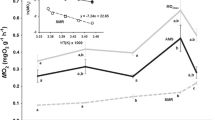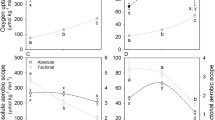Abstract
Maximal rates of oxygen consumption in vitro have been measured under standardized conditions at three test temperatures (5°, 15°, 25°C) on minced preparations of red muscle from 10 species of shallow-water marine teleost fishes. These fishes came from three different geographic areas, two with cool average water temperatures (near 15°C: coastal southern California, Galápagos Islands) and one with warm average water temperatures (near 25°C: Hawaiian Islands). The group is made up of post-juvenile or adult epipelagic fishes, which are moderately or very active in terms of their locomotor activities. A large part of the range of phylogenetic diversity among the teleosts is represented, as is the body weight range from a few grams to several kilograms. The purpose of the work is to provide part of a set of tissue-metabolism data on shallow-water fishes for future comparison with similar results from deep-sea species. Of 8 complete curves for oxygen uptake rate versus temperature (R-T curves), 6 are normal in shape (Q10≧1.5), 1 is normal but with a low Q10, and 1 is partly flat, partly normal. The differences between the species in terms of both absolute positions and slopes of the R-T curves are not related in any consistent way to any of the three testable variables: phylogenetic position, long-term adaptation temperature, and body size. The red muscles of a variety of adult epipelagic fishes, at ecologically realistic temperatures, are shown to be exceptions to the general rule that tissues of ectothermous lower vertebrates have lower metabolic rates than comparable tissues of non-torpid endothermous higher vertebrates. This circumstance probably is a major factor in the great capacities for sustained high-speed swimming shown by most epipelagic fishes. Other physiological and ecological implications of the results are discussed.
Similar content being viewed by others
Literature cited
Bilinski, E.: Lipid catabolism in fish muscle. In: Fish in research, pp 135–152. Ed. by O. W. Neuhaus and J. E. Halver, New York: Academic Press 1969.
Bone, Q.: On the function of the two types of myotomal muscle fibre in elasmobranch fish. J. mar. biol. Ass. U.K. 46, 321–349 (1966).
Caldwell, R. S.: Thermal compensation of respiratory enzymes in tissues of the goldfish (Carassius auratus L.). Comp. Biochem. Physiol. 31, 79–93 (1969).
Carey, F. G., J. M. Teal, J. W. Kanwisher, K. D. Lawson and J. S. Beckett: Warm-bodied fish. Am. Zool. 11, 135–145 (1971).
Dean, J. M.: The metabolism of tissues of thermally acclimated trout (Salmo gairdneri). Comp. Biochem. Physiol. 29, 185–196 (1969)
Gordon, M. S.: Oxygen consumption of red and white muscles from tuna fishes. Science, N.Y. 159, 87–90 (1968).
—: Comparative studies on the metabolism of shallow-water and deep-sea marine fishes. I. White-muscle metabolism in shallow-water fishes. Mar. Biol. 13, 222–237 (1972).
Hess, A.: Vertebrate slow muscle fibers. Physiol. Rev. 50, 40–62 (1970).
Hidaka, T. and N. Toida: Biophysical and mechanical properties of red and white muscle fibres in fish. J. Physiol. 201, 49–59 (1969).
Stevens, E. D. and F. E. J. Fry: Brain and muscle temperatures in ocean caught and captive skipjack tuna. Comp. Biochem. Physiol. 38 A, 203–211 (1971).
Wittenberger, C.: Biologie du chinchard de la Mer Noire (Trachurus mediterraneus ponticus). XV. Recherches sur le métabolisme d'effort chez Trachurus et Gobius. Mar. Biol. 2, 1–4 (1968).
—, A. Coro, G. Suárez and N. Portilla: Composition and bioelectrical activity of the lateral muscles in Harengula humeralis. Mar. Biol. 3, 24–27 (1969).
— and I. V. Diaciuc: Effor metabolism of lateral muscles in carp. J. Fish. Res. Bd Can. 22, 1397–1406 (1965).
Author information
Authors and Affiliations
Additional information
Communicated by J. Bunt, Miami
Rights and permissions
About this article
Cite this article
Gordon, M.S. Comparative studies on the metabolism of shallow-water and deep-sea marine fishes. II. Red-muscle metabolism in shallow-water fishes. Marine Biology 15, 246–250 (1972). https://doi.org/10.1007/BF00383554
Accepted:
Issue Date:
DOI: https://doi.org/10.1007/BF00383554




